
German postcard by Verl. Herm. Leiser, Berlin-Wilm., no. 6053. Berlin. Photo: Atelier Binder, Berlin.
Albert Paulig (1873-1933) was a popular actor in the German silent cinema of the 1910s and 1920s.

German postcard by Verlag Herm. Leiser, no. 6120. Photo: Atelier Rembrandt, Berlin-Charlottenburg. Carl Clewing in the role of Leon, the kitchen help in a stage production of 'Weh' dem, der lügt!' by Franz Grillparzer.
German actor Carl Clewing (1884-1954) was an opera singer, the composer of the song 'Alle Tage ist kein Sonntag' (Not every day is a Sunday) and a Music professor in Berlin. During the years of the early cinema, he was much in demand as a film actor.

German postcard by Verlag Hermann Leiser, Berlin-Wilm., no. 6126. Photo: G. De Virgiliis.
Livio Pavanelli (1881-1958) was an Italian actor of the Italian and in particular German silent cinema. He also worked in Italian sound cinema as an actor and as a production manager. He directed four Italian films, both in the silent and the sound era.

German postcard by Verlag Hermann Leiser, Berlin-Wilm., no. 6139.
Prima ballerina, dancer, singer and actress Liane Haid (1895-2000) was the first film star of Austria. She was the epitome of the 'Süßes Wiener Mädel' (Sweet Viennese Girl) and from the mid-1910s on she made close to a hundred films.
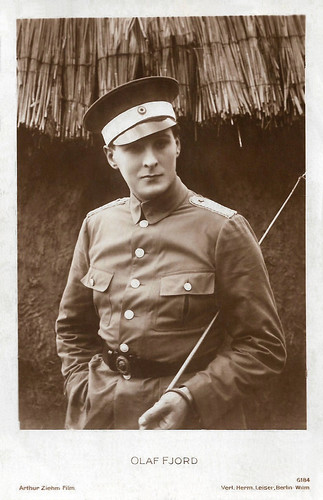
German postcard by Verlag Hermann Leiser, Berlin-Wilm., no. 6184. Photo: Arthur Ziehm Film. Olaf Fjord in Ich hatt' einen Kameraden/I had a comrade (Conrad Wiene, 1926).
Olaf Fjord (1897-1945) was an Austrian film actor, director, and producer. He appeared in numerous Austrian, German, French, and Czech silent films.

German postcard by Verlag Hermann Leiser, Berlin-Wilm., no. 6253. Photo: Atelier Eberth, Berlin. Hilde Wörner in Die Berliner Range/The Berlin Urchin (Max Mack, 1913).
Hilde Wörner (1895-1963) was a German stage and film actress, who also worked as a filmmaker. She appeared mainly in silent films, had her own series and her most notable film was Ernst Lubitsch’s Die Flamme (1922).

German postcard by Verlag Hermann, Leiser, Berlin-Wilm., no. 6260. Photo: Kühn & Hitz, Baden-Baden.
German actor Carl de Vogt (1885-1970) was a kind of Indiana Jones in the silent films of Fritz Lang. De Vogt was also a popular singer and made several records in the 1920s.

German postcard by Verlag Herm. Leiser, Berlin-Wilm., no. 6325. Photo: Hegewald-Film.
Henry Stuart (1885-1942) was a British-Swiss actor, director and writer, who worked mostly in German silent cinema.

German postcard by Verl. Herm. Leiser, Berlin-Wilm., no. 6381. Photo: Rembrandt, Berlin.
Austrian actor Egon von Jordan (1902-1978) appeared in 85 films between 1923 and 1974. The elegant gentleman was a star in German and Austrian silent films, but later he merely appeared in supporting and small roles, including as the Austrian prime minister in the very successful Sissi trilogy.
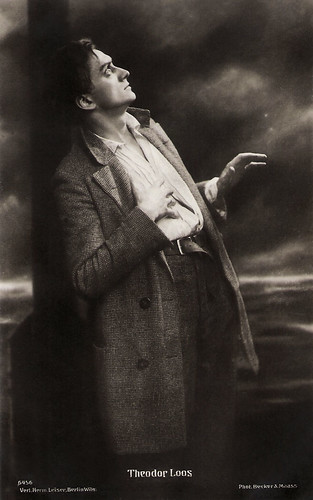
German postcard by Verlag Herm. Leiser, Berlin-Wilm., no. 6456. Photo: Becker & Maass.
Theodor Loos (1883-1954) was a German stage and screen actor between the 1910s and the 1950s. He became famous for his parts in Fritz Lang’s German films.
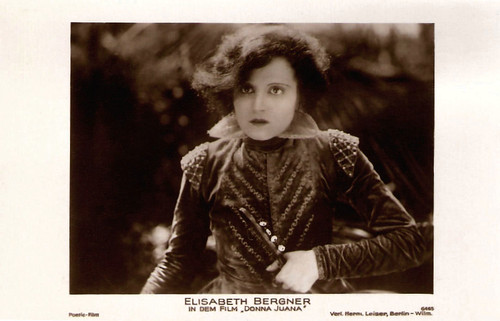
German postcard by Hermann Leiser, Berlin-Wilm., no. 6465. Photo: Poetic-Film. Elisabeth Bergner in Doña Juana/Donna Juana (Paul Czinner, 1928).
The profoundly sensitive acting of Austrian-British actress Elisabeth Bergner (1897-1986) influenced the German cinema of the 1920s and 1930s. She specialised in a bisexual type that she portrayed in Der Geiger von Florenz and in other film and stage roles. Nazism forced her to go into exile, but she worked successfully in the West End and on Broadway.
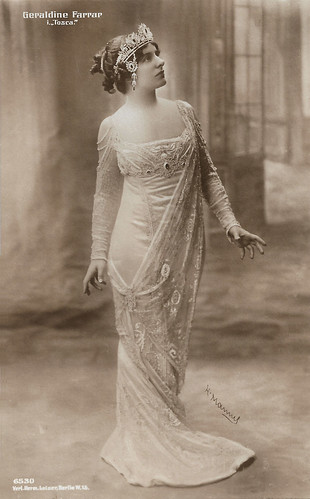
German postcard by Verlag Herm. Leiser, Berlin, no. 6530. Photo: H. Manuel. Geraldine Farrar in the opera 'Tosca'.
American soprano opera singer and film actress Geraldine Farrar (1882-1967) was noted for her glamorous beauty, acting ability, and the timbre of her voice. Barely 20, she was already the toast of Berlin. Later at the Met in New York, she had a large following among young women, who were nicknamed ‘Gerry-flappers’. Farrar also starred in more than a dozen silent films from 1915 to 1920. She was married to and co-starred with Dutch matinee idol Lou Tellegen.
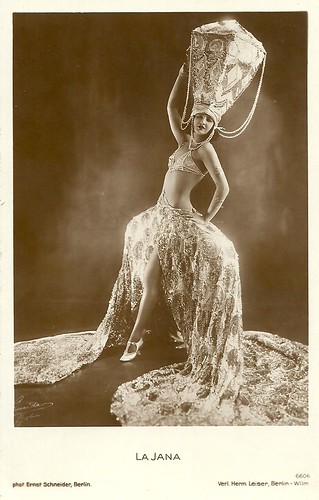
German postcard by Verlag Hermann Leiser, Berlin-Wilm., no. 6606. Photo: Ernst Schneider, Berlin. Collection: Didier Hanson.
Sexy German dancer and film actress La Jana (1905-1940) was the most popular showgirl in Berlin in the 1930s. She appeared in 25 European films, often dancing in exotic costumes. In 1940, she suddenly died of pneumonia and pleurisy.
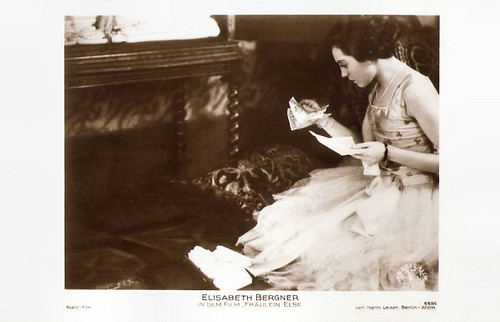
German postcard by Verlag Herm. Leiser, Berlin-Wilm, no. 6656. Photo: Poetic-Film. Elisabeth Bergner in Fräulein Else/Miss Else (Paul Czinner, 1929), based on the play by Arthur Schnitzler.
The profoundly sensitive acting of Austrian-British actress Elisabeth Bergner (1897-1986) influenced the German cinema of the 1920s and 1930s. She specialized in a bisexual type that she portrayed in Der Geiger von Florenz and in other film and stage roles. Nazism forced her to go into exile, but she worked successfully in the West End and on Broadway.

German postcard by Verlag Herm. Leiser, Berlin-Wilm., no. 6741. Photo: Trude Geiringer & Dora Horovitz, Wien.

German postcard by Verlag Herm. Leiser, Berlin-Wilm., no. 6895. Photo: Rembrandt Atelier.
Austrian actress Helene Thimig (1889-1974) was an important stage performer during the Weimar Republic. She came from a renowned acting family: she was the daughter of Hugo Thimig and the sister of Hermann Thimig and Hans Thimig. She fled the Nazis with her later husband, theatre producer/director Max Reinhardt, sought refuge in Hollywood, and appeared in 18 Hollywood films. After the war, she returned to Vienna where she had a prolific stage career but only sporadically appeared in films.

German Postcard by Verlag Hermann Leiser, Berlin-Wilm., no. 6990. Photo: Gerlach & Co. Collection: Didier Hanson.
German actress and dancer Rita Sacchetto (1879-1959) was in the 1910s a star of the Danish Nordisk Film Company.

German postcard by Verlag Hermann Leiser, Berlin-Wilm., no. 7132. Photo: Gerlach.
'Modern' American actress Fern Andra (1893-1974) became one of the most popular film stars of the German cinema in the 1910s and early 1920s. In her films, she mastered tightrope, riding horses without a saddle, driving cars and motorcycles, bobsleighing, and even boxing.

German Postcard by Verlag Hermann Leiser, Berlin,-Wilm., no. 7185. Collection: Didier Hanson.
German actress and dancer Rita Sacchetto (1879-1959) was in the 1910s a star of the Danish Nordisk Film Company.
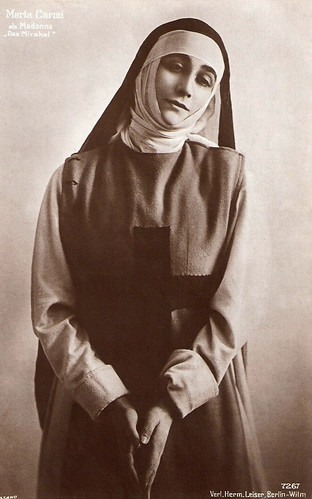
German postcard by Verleih Hermann Leiser, Berlin-Wilmersdorf, no. 7267. Maria Carmi as the Madonna in Das Mirakel/The Miracle (Max Reinhardt, 1913).
With her aristocratic air, her severe looks but also her sweet undertones, Italian silent film star and stage actress Maria Carmi (1880-1957) was the cinematic translation of the 19th century Primadonna. Later she became Princess Norina Matchabelli and was co-founder of the perfume company Prince Matchabelli.

German postcard by Verl. Hermann Leiser, Berlin-Wilm., no. 7282. Asta Nielsen in Die weissen Rosen (Urban Gad, 1916).
Danish silent film actress Asta Nielsen (1881-1972), was one of the most popular leading ladies of the 1910s and one of the first international film stars. Of her 74 films between 1910 and 1932, seventy were made in Germany where she was known simply as "Die Asta". Noted for her large dark eyes, mask-like face and boyish figure, Nielsen most often portrayed strong-willed passionate women trapped by tragic consequences.

German postcard by Verl. Hermann Leiser, Berlin-Wilm., no. 7325.
German silent film actress Dorrit Weixler (1892-1916) anticipated such better-known comedy stars of the German cinema as Ossi Oswalda and Anny Ondra. The career of the bright and light comedienne was like a candle burning on both sides.

German postcard by Verlag Hermann Leiser, Berlin-Wilm., no. 7398. Photo: Max Pallenberg as Johannes Nepomuk Zawadil in the play 'Die Familie Schimek' by Gustav Kadelburg. In 1916 the play was perfomed by the Deutsches Theater Berlin under the direction of Emil Jannings.
Max Pallenberg (1877-1934) was an Austrian singer, actor and comedian. He was one of the most important comedians of his time and often played under the direction of Max Reinhardt. Although Pallenberg was successful as a stage comedian, he only incidentally accepted roles in films.

German postcard by Verlag Hermann Leiser, Berlin-Wilm., no. 7481. Photo: Gerlach.
Swedish actor and film director Nils Chrisander (1884-1947) made his first screen appearances in German and Swedish silent films in the mid-1910s. In 1916, he was the first Phantom of The Opera on the screen. Later he moved to Hollywood, where he also directed a few films.

German postcard by Verlag Hermann Leiser, Berlin, no. 7510. Photo: Hans Böhm. Albert Bassermann as Percy in the play 'König Heinrich IV' (Henry IV).
Albert Bassermann (1867–1952) was one of the first great German stage actors who worked for the cinema. In 1933 he fled the Nazi regime and became an Oscar-nominated stage and film actor in the US.

German postcard by Verlag Hermann Leiser, Berlin-Wilm., no. 7552. Photo: Fritz Richard. Alexander Moissi as Fedja in Leo Tolstoy's play 'Der lebende Leichnam' (The Living Corpse).
Albanian-Austrian Alexander Moissi (1879-1935) was one of the great European stage actors of the early-20th century. The attractive and charismatic women's idol also appeared in several silent and early sound films.

German postcard by Verlag Hermann Leiser, Berlin-Wilm., no. 7574. Photo: Becker & Maass. Caption: Paul Wegener as Macbeth. Publicity still for a stage production of 'Macbeth' by William Shakespeare.
German actor, writer, and film director Paul Wegener (1874-1948) is one of the true fathers of the horror and fantasy genre, particularly remembered for his three silent films centred around the Jewish legend of the Golem. Wegener was one of the pioneers of German cinema who realized the potential of the new medium and used the possibilities of cinematic trick photography as a method for presenting fantastic tales in a serious matter.
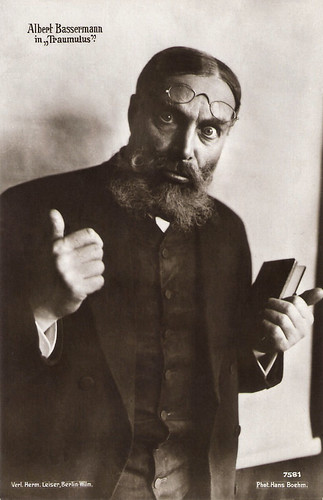
German postcard by Verl. Hermann Leiser, Berlin- Wilm., no. 7581. Photo: Hans Böhm. Albert Bassermann in the stage play 'Traumulus' by Arno Holz.
Albert Bassermann (1867–1952) was one of the first great German stage actors who worked for the cinema. In 1933 he fled the Nazi regime and became an Oscar-nominated stage and film actor in the US.
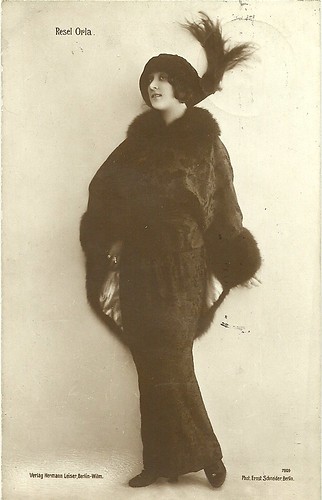
German postcard by Verlag Hermann Leiser, Berlin-Wilm., no. 7809. Photo: Ernst Schneider, Berlin. Collection: Didier Hanson.
Ressel Orla (1889-1931) was an actress of the German silent film who peaked in the late 1910s and early 1920s.

German postcard by Verlag Herm. Leiser, Berlin Wilm., no. 7857. Photo: Becker & Maass. Theodor Loos in the stage version of 'Hanneles Himmelfahrt' (Hannele's Ascension) (1913), written as a 'dream poem in two acts' by Gerhart Hauptmann, and first performed at the Königliches Schauspielhaus, Berlin, on 14 September 1893. The Deutsches Künstlertheater first performed this version in 1913, directed by Rudolf Rittner, with sets by Rochus Gliese and music by Max Marschalk, the elder brother of Hauptmann's later lover and wife Margarethe. The play had Theodor Loos as the teacher Gottwald and a young Anneliese Wagner aka Annalisa Wagner as young Hannele. Loos would play the same role in the eponymous silent film adaptation of 1922 by Urban Gad, and the sound version of 1934 by Thea von Harbou.
Theodor Loos (1883-1954) was a German stage and screen actor between the 1910s and the 1950s. He became famous for his parts in Fritz Lang’s German films.
To be continued tomorrow!
Source: Jean Ritsema (Ross Postcards).
No comments:
Post a Comment